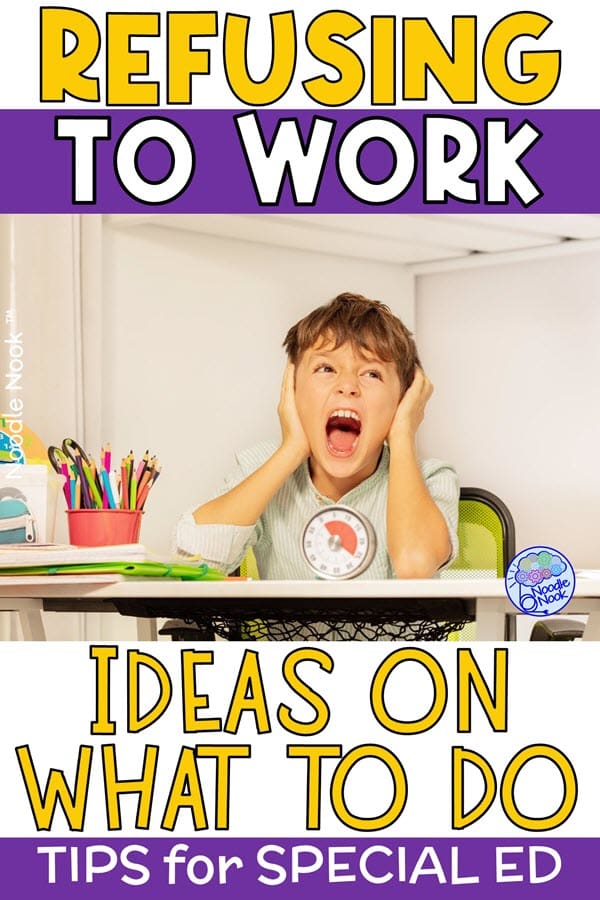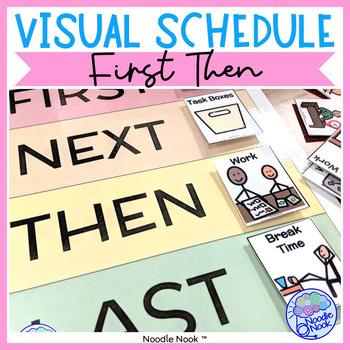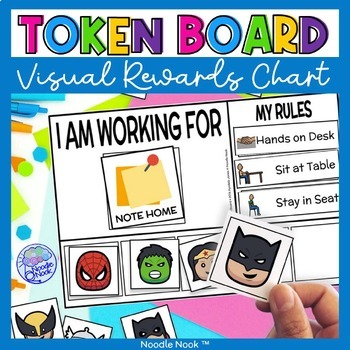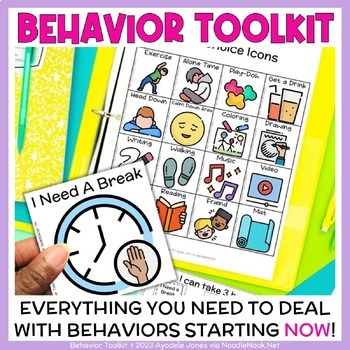What do you do as a special ed. teacher when a student with autism refuses to work? It all depends on the function of the behavior! Listen to better understand four possible reasons a student may refuse to work and learn three strategies to address each of those 4 reasons. That means you’ll have the 12 best strategies to deal with work refusal!
This episode on Noodle Nook is all about a student refusing to work.
“I have a student who refuses to work… REFUSES. I’m not exactly sure that to do. I’ve tried to build a relationship, but that’s just not cutting it. What should I do next?” -LaKeya
Before we can even start to address getting a student to work, we have to figure out why the student is refusing. We have to know the function of the behavior.
There are 4 main reasons a student may refuse to do the work:
- Don’t know how.
- Not motivated to do it.
- They don’t like the work.
- They like to say ‘NO’.

What To Do When a Student with Autism Refuses to Work
When you are working with a student who does not know ‘how’ try these strategies:
- Review your expectations
- Break the task down and model steps
- Shorten the task or assignment
When working with a student who is struggling to understand how to complete a task, it’s important to first review the expectations. Make sure the student understands the objective and what is expected of them. If they still seem unsure, try breaking the task down into smaller, more manageable steps. Then model each step for them and have them practice each one before moving on to the next.
If the task or assignment is still too challenging, try shortening it or breaking it down even further. Remember, the key is to be patient and provide the necessary support and guidance.

When you are working with a student who is not motivated to work, try these strategies:
- Implement a rewards system
- Use visuals like a first-then and visual schedule
- Offer the student choice
When a student isn’t motivated to work, it can be challenging to find ways to engage them. One strategy that can be effective is to implement a rewards system. This could be in the form of a token economy (which is my favorite). This is where the student earns a token for completing a task or set of tasks. They can then exchange those tokens for a desired reward, like a tangible item or preferred task.
Another strategy is to use visuals such as a first-then chart or a visual schedule. This are super effective visuals that can help the student immensely. It helps communicate what is expected of the student and provides them with a clear sense of structure. Additionally, offering the student choice in their tasks can also be a helpful motivator. We all like being in charge, right? By giving students a sense of control over their learning, they may feel more invested in the task at hand.
When you are working with a student who doesn’t like the work, try these strategies:
- Offer the student choice
- Offer fresh options
- Find a student’s preferred items and motivation
When working with a student who doesn’t like to work is tough. They’re usually just not interested, like at all. For these students, it can be helpful to offer them choices in their tasks. Giving them a sense of control over their learning can increase their motivation and engagement. After all, they picked the thing they’re about to do!
Also, offering fresh options or new ways to approach the task can help to make the work feel more interesting and relevant. Use real-world examples as much as possible. To get a better understanding of the student, try to find out what his/her preferred items or motivations are. It could be a favorite toy, a specific type of music, or even a particular food. Incorporating these elements in the learning activities can make the task more appealing to the student and increase their likelihood of doing the work.
When you are working with a student who likes to say ‘NO’, try these strategies:
- Offer choice, even if it is two preferred activities or two non-preferred
- Phrase choice in options, not in yes-no questions
- Use a rewards system or visual token board
When working with a student who frequently says “no,” it can be helpful to offer choices in activities. Giving them options, even if it is between two preferred activities or two non-preferred, can give them a sense of control and autonomy in their learning. Instead of phrasing choices in yes-no questions, present them as options to choose from.
Add to that the use of a rewards system or visual token board, and you can easily provide positive reinforcement for making choices and following through with them. This can help to build a positive association with making choices and increase the likelihood that the student will continue to participate in the future.
RECAP: What To Do About Student Refusals
With these strategies, you will be able to get a student in your autism unit to be more likely to work.
To learn more about token boards or rewards charts and how to use them, read this post and watch the video to see it modeled. To purchase the Visual Schedule featuring Boardmaker or the Token Board Rewards System, visit the Noodle Nook store.
Remember, you need meaningful visuals in your Autism unit or Special Ed classroom. If you don’t have them, read this post now to get some inspiration on what you need to succeed!
Good Luck Lakeya… Stay strong and teach on!
Article Citation: [cite]








These strategies MIGHT work with a very young child. I think they’d be much less successful with children over 7 or 8. These assume the child has communicated interests OR can be motivated, for example. It also presumes you have an endless list of options for students which is unrealistic. Often there really multiple creative approaches or alternatives to a task We’ve found that students who may initially be interested or motivated by a choice or small reward, often quickly lose steam and the process starts from square one.
I came across this while searching for ideas to help my 8yr old son in the same situation. The trouble is the teacher has tried all of the above suggestions and none of them worked! In fact many strategies she has tried have made it worse, especially the rewards idea.
If anyone has some different ideas I would be interested. The more I think about it the more I think some kids just aren’t suited to the school system. It’s not for everyone. If you are an adult and you hate your job you can leave it, but you have no options as a kid. All you can do is refuse to do your school work.
These kids need a totally different system. School isn’t the only way you can learn things.
I agree with Janet. These strategies MIGHT work with a student under age 7 but what do you do with a student with autism who is middle school or high school age who is angry and refuses to do anything no matter what incentives you offer?
I speak from experience. On my caseload, I have an 18 year old student on the autism spectrum who did not want to come to school today but was forced to. I told him what was expected for math instruction today, gave him two choices (one of which was a game) and told him the incentive he can earn. Nope, none of those worked because of the anger and frustration he was feeling. We just sat there while I tried to engage him with fun things such as doodling, helping me with a crossword puzzle etc.
I tried to talk to him about why it is important to be in school and he became argumentative with me. I refused to argue with him and so we lapsed into silence. I have been working with him since January and most of the time all the strategies I used today work, but not today! How do I break through to a student who refuses to do anything you ask them to do when they are frustrated?
Comments are closed.